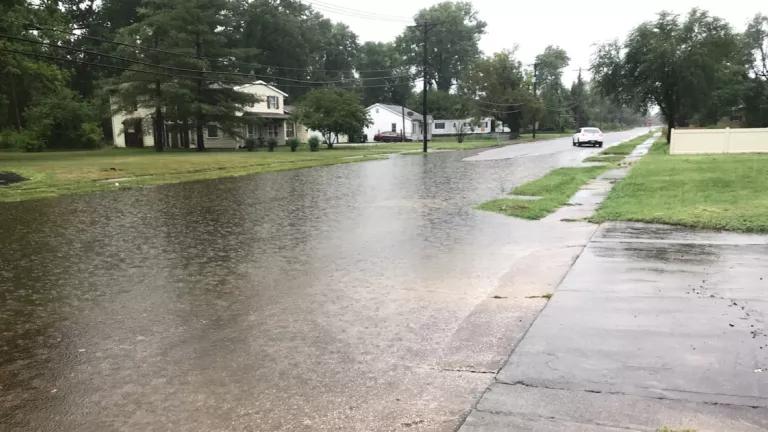A new report from the Illinois-based Prairie Rivers Network shows that 172 public water systems have exceeded safe drinking water standards for nitrates at least once in the last three decades. Using EPA’s SDWIS Federal Reporting system, NRDC found that 12 of the 172 public water systems failed to meet health-based water quality standards for nitrate not just once, but repeatedly, with 10 to 29 violations in that time frame. In our research, NRDC found that of the 12 water systems with the highest number of nitrate violations in Illinois, half of them served populations under 3,300. This could indicate two things: 1) smaller populations may be at higher risk of nitrate-contaminated drinking water, and 2) they may lack the resources necessary to resolve issues of nitrate contamination.
With nearly 27 million acres of farmland, Illinois’ agriculture industry is a significant source of nitrate contamination. When pollution from cropland runoff is left unchecked, rural communities are particularly vulnerable to health problems associated with nitrate contamination above the safe drinking water standard, such as blue baby syndrome in infants and cardiovascular disease. Long-term exposure to nitrates negatively affects thyroid function, can cause cancer, and can also lead to developmental defects. According to NRDC’s “Threats on Tap” report, more than 450 health-based violations for nitrates in community water systems affected the quality of drinking water for more than 1.3 million people in the United States in 2015.
| Water System Name | City, County | Population Served | Number of Violations for the Safe Drinking Water Standard for Nitrates since 1980 | Number of Violations of the Safe Drinking Water Standard for Nitrates in the past 5 years |
| Georgetown | Georgetown, Vermilion County | 3,678 | 29 | 0 |
| Blue Mound | Blue Mound, Macon County | 1,300 | 24 | 3 |
| Autumn Ridge Estates | Morris, Grundy County | 40 | 23 | 1 |
| Decatur | Decatur, Macon County | 76,122 | 22 | 0 |
| Maeystown | Maeystown, Monroe County | 157 | 21 | 21 |
| Olivet PWD | Georgetown, Vermilion County | 325 | 21 | 0 |
| Mount Zion | Mount Zion, Macon County | 5,833 | 17 | 0 |
| Aqua Illinois-Vermilion County | Danville, Vermilion County | 38.000 | 16 | 0 |
| Arenzville | Arenzville, Cass County | 419 | 15 | 0 |
| Catlin | Catlin, Vermilion County | 2,087 | 11 | 0 |
| IL American-Streator | Belleville, St Claire County | 18,472 | 11 | 0 |
| Westville | Westville, Vermilion County | 3,791 | 11 | 0 |
While the EPA’s data show that fewer health-based drinking water violations have occurred in recent years, nitrates in source water may be increasing. For example, the table above shows that prior to the past 5 years, Vermillion County’s water supplies consistently failed to meet the health based standard for nitrates. In the past five years, Vermillion County’s drinking water violations have decreased, but a recent study by the Northeast Midwest Institute reveals that Vermillion County’s source water still experiences seasonal high nitrate concentrations. From 2013 to 2016, the county’s source water tested above the EPA’s Maximum Contaminant Level (MCL) of 10 mg/L during the winter months, rising as high as 16 mg/L in the later months of 2015.The same study reveals that nitrate treatment costs Vermillion County more than $300,000 each year. Smaller towns, rural areas, and private wells may also be experiencing the same high nitrate concentrations in source waters, without resources to pay for expensive nitrate treatments.
Maeystown, IL, has struggled to meet health based standard for nitrates drinking water in recent years. The town continues to provide drinking water to its 157 residents even though it has 21 reported health-based violations of the federal safe drinking water standard since 2012. The town’s drinking water is unsafe for pregnant women and children, so the residents of Maeystown have taken it upon themselves to provide bottled water for families. As with other water systems, the source of the problem has never been addressed—or publicly identified—leading to multiple drinking water violations that continue to impact the community’s residents.
“Treating water after it has been contaminated is an expensive system that only treats a symptom. It does not address the root of the problem. It leads to Illinoisans frequently being exposed to high levels of nitrate and the continued damage to downstream ecosystems. We need a solution that will protect all Illinoisans and treat the problem before it reaches our tap water.”
How do we prevent nitrates from overloading Illinoisans’ drinking water before it reaches the tap? The Prairie Rivers Network has a few recommendations, including best management practices such as fertilizer management and planting cover crops, as well as policy solutions to fund local infrastructure and investment in conservation resources like Illinois’ Soil and Water Conservation Districts. At NRDC, we advocate for better soil management practices that help prevent nitrates from contaminating our drinking water at the source, such as cover crops. Cover crops—vegetative cover planted after the main crop is harvested—offer a practical solution to improve soil health, slow erosion, and increase crop yields among many other benefits. Planting cover crops is estimated to reduce nitrate runoff by 30% per acre, but only 1% of Illinois’ cropland is planted with cover crops. Illinois should invest in cover crops and healthy soils to not only protect rural drinking water supplies, but also to ensure that Illinois farms are more resilient to the impacts of climate change.
“In fact, using cover crops (and other soil stewardship practices, like no-till farming and compost application) to increase soil organic matter on just half of Illinois’ corn and soybean acres could help store nearly an additional 214 billion gallons of water—enough to fill the needs of nearly 6.7 million people for a year.”
—NRDC
Cover crops can do a lot to help improve water quality for Illinoisans. Programs like the Iowa Cover Crop Insurance Program offers farmers additional financial incentives to plant cover crops, easing some of the cost concerns for farmers. Illinois’ water quality problems can’t be solved by cover crops alone, but more funding for conservation in the state and incentive programs like the one in Iowa can certainly help.



